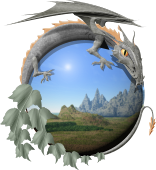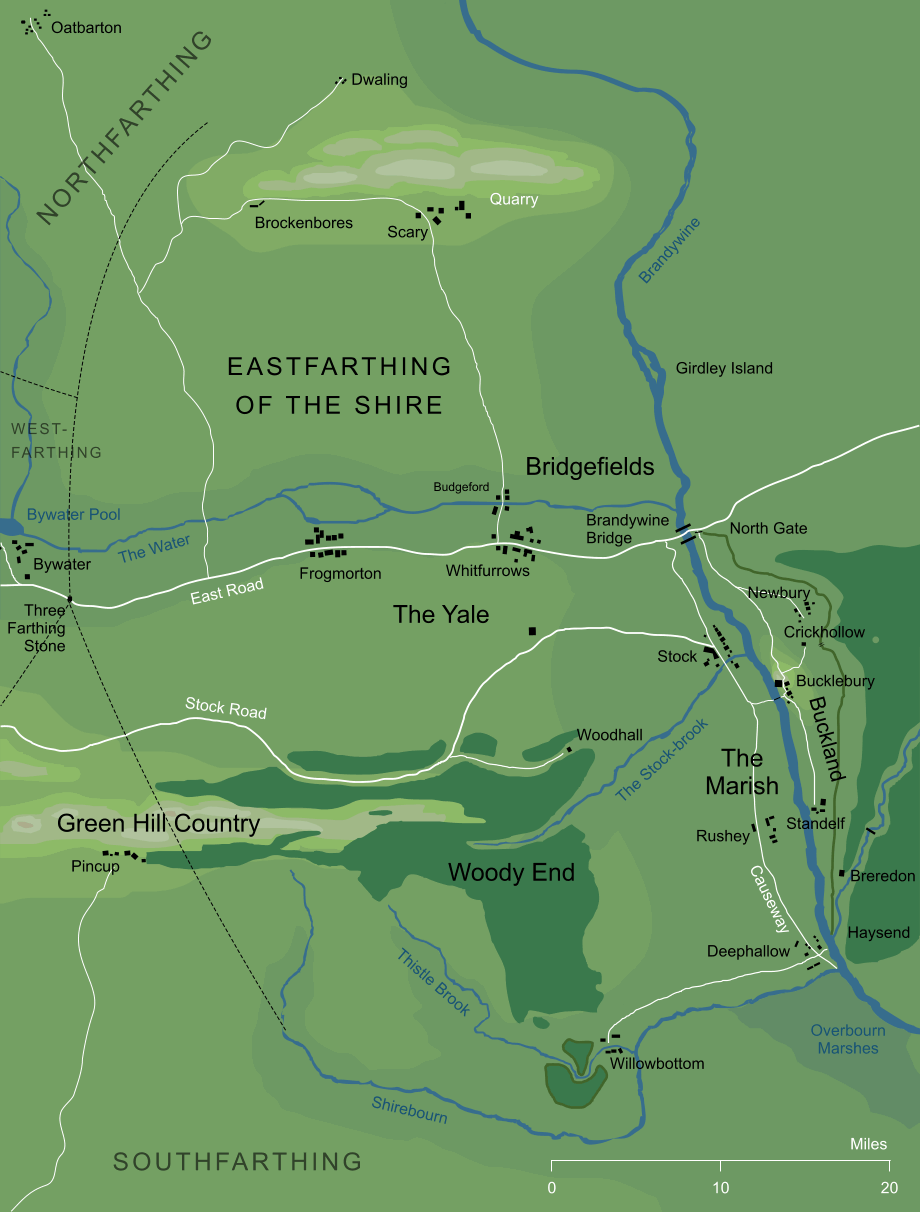- Cities and buildings
- Fields, plains and deserts
- Forests
- Hills and mountains
- Islands and promontories
- Lands, realms and regions
- Rivers and lakes
- Seas and oceans


 |
||
|


Which personality type are you?
Take the Free mydiscprofile Personality Test to discover your core personality and your ideal job.   Which personality type are you? |
|
Dates
Location
The lands between the Three-Farthing Stone and the river Brandywine
Race
Culture
Settlements
Brockenbores, Budgeford, Deephallow, Dwaling, Frogmorton, Rushey, Scary, Stock, Whitfurrows, Willowbottom, Woodhall
Meaning
'East quarter'
Indexes: About this entry:
|
Eastfarthing of the ShireThe lands east of the Three-Farthing Stone
The eastern quarter of the Shire, whose border in that direction ran along the wide river Brandywine. From the river, the Eastfarthing stretched westward for some forty miles to the Three Farthing Stone, and was at least twice that distance from its northern to southern extents. The farthing was divided into two by the East Road, which ran directly from the Brandywine Bridge to the Three Farthing Stone, passing through the towns of Whitfurrows and Frogmorton on the way. The Geography of the EastfarthingThe northern parts of the Eastfarthing were an upland region of rocky hills and outcrops. Three villages lay in this part of the farthing: Brockenbores, Dwaling and Scary, and in the hills to the east of Scary was a quarry extracting stone from the rocky hills of the region. Southward from these hills, the land became less elevated as it fell towards the valley of the Water, a stream that ran eastward across the middle of the Eastfarthing. Along this central east-west valley ran the East Road, the important route through the Shire that led to the Brandywine Bridge and the lands beyond. On this road lay the two main townships of the farthing. Near a marshy region on the course of the Water lay Frogmorton, and some miles farther east was Whitfurrows. The lands between Whitfurrows and the Bridge were known as Bridgefields, a region that contained the home of the Bolger family at Budgeford. Southward from the Brandywine Bridge, along the banks of the river Brandywine, was a boggy region known as the Marish. The main town in this area was Stock, lying at a place where the Stock-brook ran down into the Brandywine, and said to be home (in its inn, the Golden Perch) to the best beer in the Eastfarthing. From here, the long and winding Stock Road ran westward, nearly parallel to the East Road but some miles south of it, towards the Tookland in the Westfarthing. The lands of the Water-valley between the two roads was known as the Yale. Southward from Stock ran another road, a raised Causeway through the marshy riverlands, that continued on to the villages of Rushey and Deephallow. Westward of the Marish and southward of the Stock Road, the land of the Eastfarthing rose once again into low hills, especially in the Green Hill Country that ran out westward across the farthing's borders. From these higher lands rose several streams and rivers: the Stock-brook, the Shirebourn and Thistle Brook. The heights were densely wooded, and indeed this entire part of the Shire was known as Woody End. There were few settlements in this area, though the place called Woodhall lay on the northern fringes of the woods, while the village of Willowbottom lay much further south at the place where Thistle Brook ran into Shirebourn. History and Culture of the EastfarthingIt was in the year III 1601 that the first Hobbits crossed the Brandywine Bridge into the land that would become the Shire. Those first migrants would have passed along the East Road through the region that would be known the Eastfarthing. These earliest Shire-hobbits were joined some thirty years later by another group, Stoors from Dunland, who migrated northward to enter the new Hobbit-lands. These Stoors settled mainly in the Marish by the Brandywine, and for that reason the Marish had a character somewhat different from the other parts of the Shire. Because of their Stoor ancestry, its people tended to be stockier and more robust than the other Hobbits of the Shire. The wetlands where they made their homes also affected their lifestyles: they would, for instance, often wear boots (which was rare elsewhere in the Shire). The Marish was unsuitable for the making of the traditional Hobbit-holes, and so these Hobbits began to build above ground like Men, a practice that gradually spread out of the Eastfarthing and across the Shire as a whole. As the nearest part of the Shire to the Bree-land, the Eastfarthing retained certain connections to the Bree-hobbits. There was indeed some sharing of culture, seen especially in the calendars. While the rest of the Shire standardised on its own Shire Calendar, the Hobbits of the Eastfarthing kept certain idiosyncrasies from the old calendar of Bree. Visitors from Bree would come at times to the Eastfarthing, bringing news of the world beyond the Shire's borders, though these visitors became less common as the years passed. The Hobbits of the Eastfarthing, and in particular those of the Marish, would play important roles in the history of the Shire. After the loss of the Shire's patron kingdom of Arthedain, the Hobbits chose one of their number to act in place of the old King. Thus in the Shire-year 379, Bucca of the Marish became the first of a long line of Shire-thains. Centuries later, in 740 by the Shire-reckoning, one of Bucca's descendants would cross the Brandywine and establish Buckland on the river's eastern bank. This was Gorhendad Oldbuck, who changed his name to 'Brandybuck' after founding the new land and the line of the Masters of Buckland. When Frodo and his companions Samwise and Pippin set out from Bag End in III 3018, they quickly passed out of the Shire's Westfarthing and into the Eastfarthing, and continued across it towards the river. They were pursued by Black Riders, and made their escape across the countryside and eventually to Bucklebury Ferry in the Marish. From there they departed from the Eastfarthing, crossing the river to Buckland on the opposite bank before setting out on their fateful quest across Middle-earth. See also...Badgers, Boffin Family, Bolger Family, Brandybuck Family, Bree-hobbits, Bridge Inn, Brockenbores, Buckland, Bucklebury Ferry, Deephallow, Dwaling, Farmer Maggot, Farthings, First Eastfarthing Troop, Folklands, [See the full list...] Indexes: About this entry:
For acknowledgements and references, see the Disclaimer & Bibliography page. Original content © copyright Mark Fisher 1998, 2001, 2008, 2013, 2020. All rights reserved. For conditions of reuse, see the Site FAQ. Website services kindly sponsored by Axiom Discovery aptitude and skill testing.Personality is one part of understanding a candidate's suitability, but aptitudes and skills are also key. |